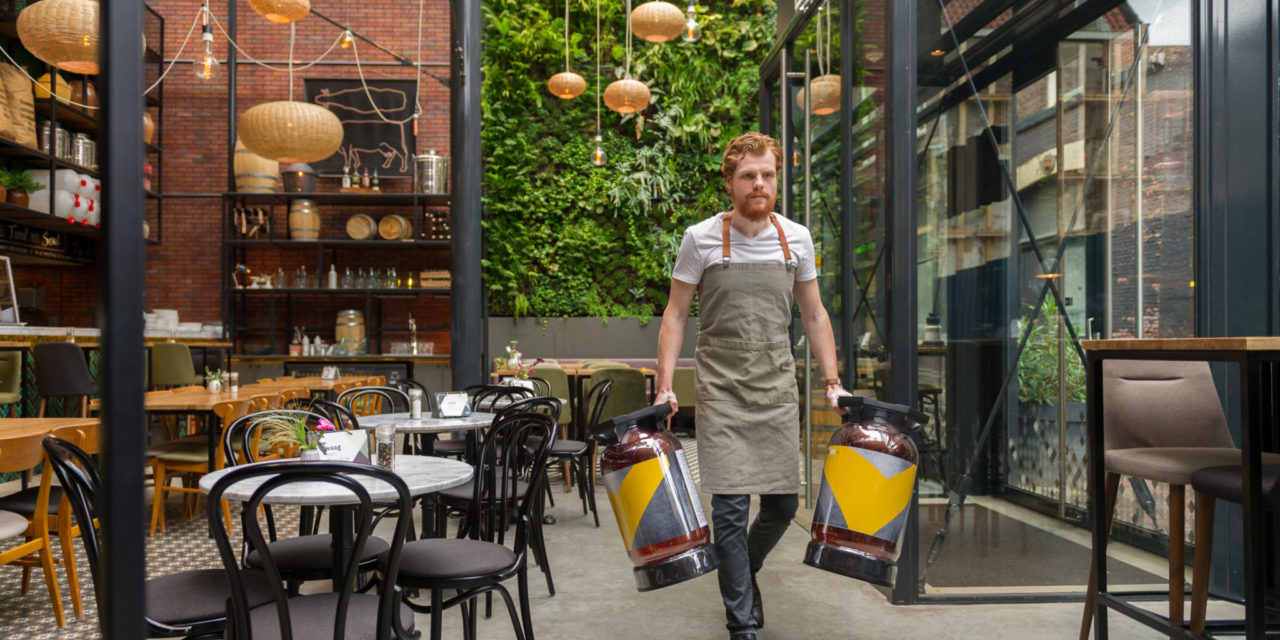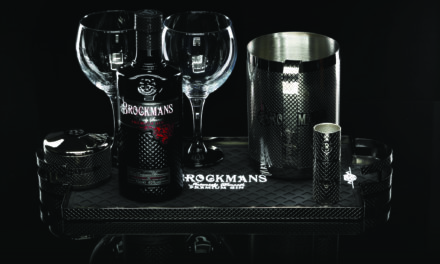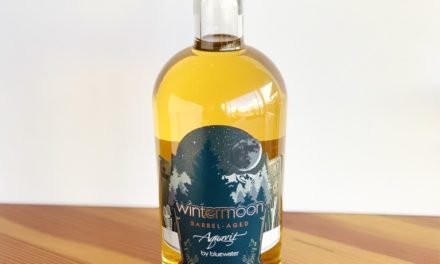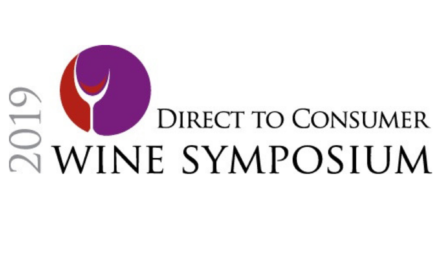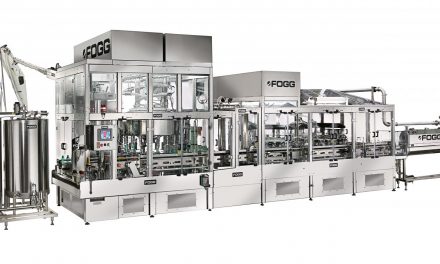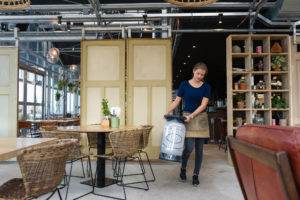
[Photo courtesy Lightweight Containers BNV]
Kegs provide numerous advantages to both beverage producers and retailers. Producers get the benefit of lower packaging costs with higher sales volumes plus the ability to enter new markets and grow brand awareness. Flexible leasing programs and other services mean less initial investment is needed to get beverages to consumers, giving smaller producers the opportunity to tap into the draft beverage market.
Kegs give retailers fresh product with higher margins. Plus, they’re available in a variety of sizes and materials, so producers can better match a retailer’s needs. They also let drinking establishments offer a greater diversity of products.

“One of the biggest barriers to entry for wine on tap is that wineries don’t know what to do when the packages come back.” —Justin Willenbrink, Blefa Kegs
Keg Material Options
Keg materials have evolved over time to accommodate both beverage producers and end users.
From wood, aluminum became the next commonly used keg material. But these kegs corroded over time, prompting a move to food-grade stainless steel, which has become the go-to for large regional breweries as well as distributors due to durability and longevity, says Justin Willenbrink, sales director for Blefa Kegs, a German supplier of stainless steel kegs for beer, wine, cider, coffee, kombucha, and soft drinks.
Brewery taprooms also find stainless kegs more profitable and the easiest to maintain, says Willenbrink.
Plastic kegs further opened markets for producers. One commonly used plastic is polyethylene terephthalate or PET (if you’ve placed a beverage bottle stamped with a “1” code on it in recycling, you’re familiar with this plastic resin material); it’s an FDA-approved, nontoxic material that’s BPA-free and deemed safe for food and beverage storage.
“PET kegs have let more beverage companies envision their product on tap,” says Benjamin Fenster, North American business development manager for Dolium, makers of one-way PET kegs (which can be recycled at their destination instead of returned to a distributor for cleaning and refilling). The reduced initial investment provides smaller beverage producers entrée into the draft beverage market, including the export market.

“PET kegs have let more beverage companies envision their product on tap.” —Benjamin Fenster, Dolium [Copyright Paul McDermott Photography]
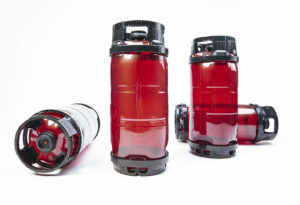
[Photo courtesy Dolium]
Pricing across the one-way keg market is fairly uniform now; however, Grit says Lightweight Containers BV is attempting to reduce costs to customers by opening new production facilities and warehouses worldwide to decrease shipping costs.
Unique Keg Programs

“Wines are shipped in bulk to Free Flow, where they’re kegged, stored, and fulfilled to distributors. The winery doesn’t need to think about the kegs once they’re sold and shipped to market. Free Flow manages the entire return logistic process.” —Heather Clauss, Free Flow Wines
Kegs aren’t a “fill it and forget it” proposition, which is why solution-based draft beverage companies help producers with issues such as sourcing and logistics. Willenbrink says wine is now the second largest draft beverage and stainless steel “is moving that segment forward.”
“One of the biggest barriers to entry for wine on tap is that wineries don’t know what to do when the packages come back,” says Willenbrink. But using a sixth-barrel in lieu of bottles helps when providing wine in volume. It’s also more environmentally friendly.
Enter California-based Free Flow Wines, which fills, leases, and tracks reusable steel kegs for wineries. “Wines are shipped in bulk to Free Flow, where they’re kegged, stored, and fulfilled to distributors who deliver to top restaurants and venues nationwide,” says Heather Clauss, the company’s vice president of marketing and customer success. The winery doesn’t need to think about the kegs once they’re sold and shipped to market. Free Flow manages the entire return logistic process.”
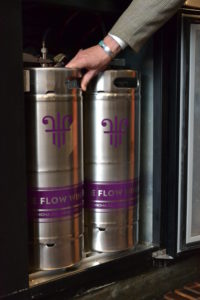
[Photo courtesy Free Flow Wines]
Unlike bottles, there’s no oxidation, and wine is served fresh and at the correct temperature every time. “Wine on tap provides more options for service, from flights to carafes, which makes it more fun and engaging for the consumer,” says Clauss. Restaurants can offer guests everything from a tasting flight to a carafe, while vendors in large venues can easily handle high-volume pouring with less waste.
Although beer is the beverage most associated with kegs, many other beverages can be dispensed from kegs. Wine-certified lines prevent issues with off-taste while inert “bev gas” or “Guinness gas” ensures the wines stay at peak freshness.
Fenster weighs in: “Any beverage that can be in direct contact with a gas—most commonly CO2, nitrogen, or argon—is a great fit for kegging.”
There are also regional variations in keg use, says Grit, explaining that some countries are well known using kegs for wine next to beer, while, “In large parts of the world, there’s increasing demand for beverages on draft and therefore in keg, instead of in bottles or cans.” He also says cold brew coffee and kombucha are more popular in the United States than in Europe, while the Japanese market is focused on beer and draft sake, for example.
Restaurants Going with the Keg-Based Flow
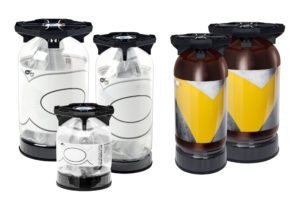
[Photo courtesy Lightweight Containers BV]
“From cocktails to wines, almost all of our alcoholic beverages are featured on draft. We do this for a number of reasons, some practical, some based on function, and some based on form,” says Mendez. A year ago, he explains, Saloniki Greek began offering draft cocktails “out of the practical need for space and efficiency” and to offer original, Greek-inspired craft cocktails. “We don’t have a tremendous amount of space, and we didn’t want to change our service model to hire or train cocktail bartenders. Kegged cocktails offered the perfect solution.” (See “Tap Into Draft Cocktails.”)
T.J. Callahan, founder of Farmhouse, a group of three Midwestern farm-to-table restaurants, says 20 percent of its draft sales come from the restaurants’ proprietary ciders, which occupy between four and six tap handles at each location. The restaurants also offer wines on draft and kegged cocktails. The kegs used at Farmhouse vary from half- or quarter-barrels to Cornelius kegs for cocktails and one-way kegs for wines. Having a keg system as well as local ingredient partners lets Farmhouse “do really interesting things in short production runs, which are fun,” says Callahan. This summer, it offered a rosé cider in two formulations in five-gallon batches.
Callahan wants to offer more alternative beverages in the future. “Our guest base is less interested in craft beer than they were a year ago—craft beer is ubiquitous,” he says. “How many malty peach sour beers can the market absorb?”
Conversely, cocktails, wine, and cider sales are growing in Callahan’s Farmhouse locations—though experiments with kombucha and cold-pressed coffee haven’t performed as well.
Future of Kegs

“The popularity of craft [beverages] is boosting draft volumes.” —Kevin Baker, GlobalData
“The decrease is due to a move away from on-premise towards off-premise consumption in major markets,” says Kevin Baker, GlobalData’s global beer and cider research manager. “In addition, there are trends within on-premise—including the growth of clubs and upmarket style bars—that favor consumption of bottled beers rather than draft.”
Increased cider drinking worldwide is driving its consumption from kegs, which increased 30 percent globally in that period. In North America, cider consumption from kegs grew 173 percent to 87.50 million liters. Despite the numbers, GlobalData’s Baker says keg market growth is evident in smaller keg sizes, including Heineken’s David and Blade keg systems. The PET keg market is also growing.
“The popularity of craft [beverages] is boosting draft volumes in some markets,” says Baker. “In developing countries, on-premise drinking is growing, which positively impacts keg volumes.”
“We envision a future where beverage producers of all kinds are able to deliver their product fresh and in a cost-effective way, all over the world,” Fenster continues. “Tap lines, both self-serve and employee-operated, will dispense a variety of beverages at restaurants, bars, offices, schools, cruise ships, stadiums, concert halls, and other venues. “
Food service establishments—bars and restaurants—report success with draft beverages. “We’ve had a completely positive experience with using kegged cocktails, wines, and beers,” says Mendez. “The value, efficiency, consistency, and quality are very difficult to replicate, so to us, it’s a win-win. We get more time to spend with our guests, we can offer them a premium experience at a below-market price, and we guarantee consistency.”
Kegs provide benefits at all stops all along the beverage supply chain. From eproducers to consumers, everyone can find a reason to raise a glass of carefully crafted liquid to the humble keg that got it there.

